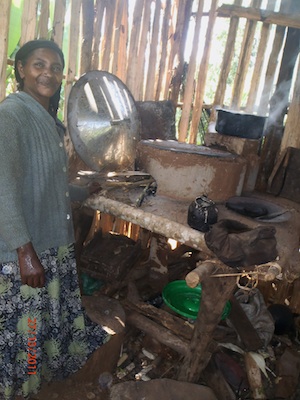Forest preservation through wood-saving stoves
 Kafa is the birthplace of wild coffee, Coffea arabica, where it has been consumed for more than 1,000 years. There are now close to 5,000 wild varieties of coffee in this biodiversity hotspot. A unique coffee culture is deeply ingrained in the Ethiopian economy and history. This culture is a key element of the participatory forest management scheme created in the Kafa Biosphere Reserve to avoid deforestation and boost economic development.
Kafa is the birthplace of wild coffee, Coffea arabica, where it has been consumed for more than 1,000 years. There are now close to 5,000 wild varieties of coffee in this biodiversity hotspot. A unique coffee culture is deeply ingrained in the Ethiopian economy and history. This culture is a key element of the participatory forest management scheme created in the Kafa Biosphere Reserve to avoid deforestation and boost economic development.
NABU (The German Nature and Biodiversity Conservation Union) and its partners have worked towards the preservation of these forests obtaining the establishment of the UNESCO Kafa Biosphere Reserve in June 2010 and implementing the project: “Climate Protection and Preservation of Primary Forests – A Management Model using the Wild Coffee Forests in Ethiopia as an Example“.
The project achieved the production and distribution of 11200 energy saving stoves to inhabitants though collaborative effort with department of energy. 70 jobless youth were trained organized and equipped and deployed in 11 production and 25 satellite sites.
The dependency on biomass energy: a driving force for deforestation
Only 40 years ago, some 40% of the Ethiopian land surface was occupied by forests. Today, less than 3% remains, largely in the Kafa coffee biosphere reserve, which still boasts large areas of mountainous afromontane cloud forest. The forest ecosystem makes an important contribution to the livelihoods of people in the area. It provides wild coffee, valuable spices and honey from wild bees. It also contains some 25 million tons carbon in above-ground biomass. Some 600,000 tons of carbon could be removed from the atmosphere annually through natural forest growth – if the forest remains intact. But it is endangered due to clear-cutting for smallholder agriculture and industrial coffee and tea plantations, and the intensive use of biomass.
Ethiopia currently caters for 96 percent of its energy requirement using biomass. Due to this fact many households satisfy their demand by cutting trees form the available natural forests/woodlands and shrub lands. This situation has been cited as one of the driving forces for deforestation. Similar to other parts of the country people of Kafa mainly use wood products for fire. The firewood comes from the nearby forests. On top of that, the biomass fuel is mostly used inefficiently. This has a direct relationship with the household income and time budget. The more inefficiently the wood is used the more time women and children will spend on firewood collection.
There is no electric power plant in the Biosphere Reserve. Electricity is supplied only to a few areas of the reserve by an external hydro-power plant.
Energy-efficient stoves and other renewable energy sources
Among the activities carried out by NABU’s Climate and Forest Project to mitigate the impact of meeting energy requirement using biomass, there are two main lines of action: promotion of community plantations with fast-growing tree species as fuel wood and introduction of efficient wood-burning stoves.
In this last case, the target of the project is to introduce energy-saving stoves to the communities in Kafa Biosphere Reserve. 11200 stoves were distributed until September 2012. The plan says that 10000 stoves will be distributed to households with high wood consumption by September 2012. The new technique of these stoves not only reduces the amount of wood needed for cooking by half, it also saves the forests, time for the user and produces less smoke and fire. The stoves are therefore a source of great relief to the people and the forest and have been very well received.
To produce and distribute the stoves NABU is working closely with the Kafa Zone Department for Water, Mines and Energy. As part of this cooperation 70 young unemployed people were trained as stove producers and supported to start their production business.
In collaboration with GLEN (Global Education Network of Young Europeans) a study has been conducted on alternative energy sources where coffee husk briquets, bio-gas and solar appeared as equally relevant.
Annually, in the area of biosphere reserve, about 100 t of coffee husk is produced. This represents an ideal material for briquetting. But not only the coffee husk: dry leftovers from other crops processing (e.g. maize, sorghum etc.) can be used as well. Another source is biogas production, based on two big potential sources: cattle dung and coffee pulp.
The Kafa Water, Mining and Energy Department has started to implement some renewable energy programs in its “5 years strategic plan” – starting from 2011. 450 PV solar panels were distributed until September 2012.
Lessons learned and potential replicability
The acceptance of wood-saving stoves is very high and they are easily adapted by users. Within this context, local communication and education are essential. The importance of the training programme for young people to help them expand their own knowledge of climate and forest protection is recognised. In turn, they can share this knowledge and raise the awareness of other members of their communities.
With regard to energy, solar power has a high potential and there are multiple benefits of using solar energy in the area. But before installing new panels it is necessary to prepare and train technical staff that will work in the zone.
The successful results of this project may have a significant impact on other areas of the region with similar characteristics and needs. This would be the case of Yayu Biosphere Reserve, also in Ethiopia, and of other similar areas, like the Ituri region in the Democratic Republic of Congo.

















